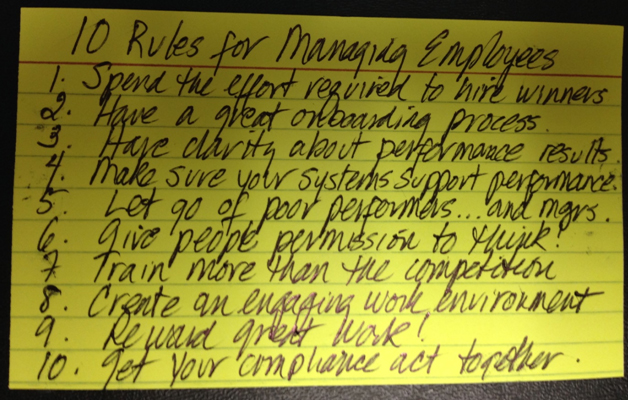Everything you need to know about Managing Employees on an Index Card
I must admit – I got the idea for this index card after listening to a podcast with Howard Pollack, a professor from University of Chicago, who said that everything you needed to know about building your financial wealth can be written on an index card. The card went viral and he followed up with a book to explain it.
So, I challenged myself to figure out what I would put on an index card for managing employees after 30 years being in the field. Here’s my index card.
If you can’t read the index card it says:
10 Rules for Managing Employees
- Spend the effort required to hire winners.
- Have a great onboarding process.
- Have clarity about performance results.
- Make sure your systems support performance.
- Let go of poor performers.
- Give people permission to think.
- Train more than the competition.
- Create an engaging work environment.
- Reward great work!
- Get your compliance act together.
Now let me try to briefly explain each one. I dig in further on the video here.
- Spend the effort required to hire winners- Unfortunately most managers few hiring as something to get over with. Make sure your managers understand hiring great employees is the most important thing they will ever do.
- Have a great onboarding process- I’m amazed by how poorly some employees begin their work experience. Great employers have a well-oiled onboarding process which gets newbies producing asap. Their first day, week and month should be carefully planned. Don’t wing it when it comes to onboarding.
- Have clarity about performance results- Perhaps the greatest problem with performance management is the lack of clarity about what it means to perform. There’s a simple question you can ask an employee: how would you know if you’re doing your job well without having to ask me, or without me having to tell you? If their answer is not spot on you’ve done a poor job of managing their performance.
- Make sure your systems support performance- It’s not just about performance clarity, it’s also about supporting performance. Dr. W. Edwards Deming opined that 9 out of 10 employees want to do a good job every day. It’s the system that allows them to do so. This system starts in the hiring process by making sure you don’t hire misfits. Often the “system” is that person’s immediate manager. Half of all managers manage better than the other half. What training are your managers getting?
- Let go of poor performers… and managers- Here’s a question for you – do you have anybody working for you that if they quit you would be more relieved than upset? If so, why are they still there? Is it the bosses kid? Do they have photos? What is it? Keeping poor performers sends a message to everyone else that mediocrity… or even worse… is acceptable. Managers are often the source of employee performance problems. Sometimes it’s time to let them go too.
- Give people permission to think- None of us is as smart as all of us. The whole idea of controlling a business from the top down is out of step with today’s reality. When you give people permission to think you allow them to focus on work they know best, provide suggestions, and look for new business opportunities. I encourage employers to have mandatory suggestion meetings to drive past the fear involved of people actually thinking!
- Train more than the competition- George Gilder reminds us we are in a knowledge economy. In a knowledge economy, it is education that offers the greatest leverage for both employee and company. Not surprisingly, the most successful companies out train their competition. Given all of today’s online offerings, the out of pocket cost of training is minimal compared to the employee’s time involved in it. If you want to obtain a return on investment with training examine how it has actually improved performance.
- Create an engaging work environment- Your work environment is always communicating. It is never not communicating. What story does your environment communicate? Ask yourself whether the work environment is engaging or not? I encourage employers to fill their walls with vision statements, success stories, employee inspired artwork, powerful quotes and more. Allow your employees permission to decorate their work areas as the result fits within reasonable guidelines.
- Reward great work- As stated in Barber’s Book of 1000 Proverbs, “The greatest benefit is the one last remembered.” In my experience when we run 75 mph we focus on those aspects of an employee’s performance that drive us nuts and ignore their great work …because that’s what we expect from them. This is a big mistake and one of the main reasons employees leave companies. While I’m not a big fan of rewarding people simply for showing up, I am big fan of rewarding great work as soon as possible!
- Get your compliance act together- Last, employee lawsuits are ridiculously expensive but most employers don’t appreciate the risk until they have suffered it. Do yourself a big favor and if don’t already have access to ThinkHR from your broker or payroll company then get it from me! I’ll offer you a deal that simply too good to refuse.
There are my 10 rules. What would add or take away from your 10 Rules for Managing Employees index card list?
Note I also did a video about this list you can watch here. If you like it please share with a friend or provide a comment. Thanks!


